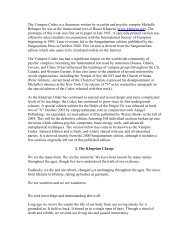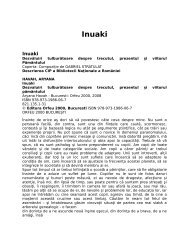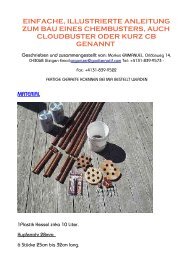Modern Orgone - Transkommunikation.ch
Modern Orgone - Transkommunikation.ch
Modern Orgone - Transkommunikation.ch
You also want an ePaper? Increase the reach of your titles
YUMPU automatically turns print PDFs into web optimized ePapers that Google loves.
Minerals<br />
In addition to the metals, you can add any of the<br />
following minerals in small amounts, they are all<br />
IMO safe for general purpose use:<br />
Amethyst<br />
Turquoise<br />
Rose Quartz<br />
Citrine<br />
Selenite<br />
Kyanite<br />
Tourmaline<br />
Hematite and lapis lazuli are also great but may too<br />
strong for some folks, some people react badly to<br />
hematite and some people get over stimulated by<br />
lapis lazuli.<br />
That said, I often work with a combination of<br />
turquoise, lapis lazuli and hematite in my HHGs<br />
and TBs.<br />
Organic Material<br />
Before you ask, the word ‘organic’ means ‘made<br />
mostly out of carbon atoms’. It does NOT mean<br />
‘formerly living tissue’, ‘of natural origin’, ‘nontoxic’,<br />
‘environmentally friendly’ or anything else<br />
similar.<br />
The most commonly used organic resin is polyester<br />
resin with MEKP catalyst, used normally for<br />
fiberglass work. It is nasty to work with but works<br />
just fine for making orgone matrix material. Do not<br />
go and ask for polyester resin at the hardware store<br />
they won’t know what you mean; ask for fiberglass<br />
resin and they will know what you mean. Polyester<br />
resin often cracks while curing and for HHGs the<br />
small cracks do not affect the performance of the<br />
device mu<strong>ch</strong>, unless they cause the casting to fall<br />
apart.<br />
Another plastic resin you can use is epoxy. Epoxy<br />
is also nasty to work with but works just as well for<br />
making HHGs. While epoxy is not as prone to<br />
cracking as polyester, it also does not shrink away<br />
form the sides of the mold when it cures.<br />
Sometimes shrinking away form the mold makes it<br />
easier to remove the finished casting.<br />
Acrylic casting plastic also works well and is<br />
generally a bit more expensive than polyester of<br />
epoxy. It is not prone to cracking but tends to trap<br />
small air bubbles. It does not shrink away form the<br />
side of the mold when it cures. It has a slightly<br />
nicer feel than polyester but IMO not nice enough<br />
to warrant the often 3x price.<br />
Hardened pit<strong>ch</strong> from trees is a natural resin that you<br />
can use. While not as durable and possessed of<br />
tendency to soften and sag when left in the hot sun,<br />
it is a natural material and has a nice feel to it.<br />
Beeswax can also be used but again is neither as<br />
efficient as pit<strong>ch</strong> nor even as durable as pit<strong>ch</strong>.<br />
Plastic resin are generally used because they are<br />
easily available, durable and economical compared<br />
to most of the other alternatives.<br />
You can mix a small amount of powdered herbs<br />
into the resin for a semi-homeopathic effect. I leave<br />
it to you to decide what herbs are best used, and<br />
suggest that you spend some time reading up on it.<br />
As a simple suggestion, I might recommend sage,<br />
as it has energetic properties that work well in an<br />
HHG, is more or less safe for general use, and is<br />
easily accessible inmost supermarkets. You only<br />
need to use a tiny amount of the sage in the resin,<br />
say 0.5 to 1.5 teaspoons of powdered sage per a<br />
gallon resin.<br />
I also sell a premix powder blend suitable for using<br />
in HHGs (by adding small amounts) or in making<br />
EXD (used with just the powder and resin).<br />
You could add a pin<strong>ch</strong> of finely powdered iron<br />
oxide (rust form steel or iron, or red earth if you<br />
can find red earth where you live) to the resin.<br />
Coils<br />
You do not need to put a mobius coil in an HHG.<br />
You can do so, put TBH the flat spiral coils are<br />
more suited to use in HHGs than a mobius coil.<br />
Adding a mobius coil <strong>ch</strong>anges the HHG into a<br />
small broadcast device. You then have to pa<br />
attention to what is running through that coil.<br />
If you want to make something with a mobius coil<br />
in it, then cast a small disk or slab of HD or XHD<br />
and put a coil in that.<br />
Programming<br />
An optional step but well worth the effort. You do<br />
not need a mobius-coil-driven generator to program<br />
resin, though of course you could build a small one<br />
to use for this purpose. An easier option to get<br />
started would be to just use a PC sound card and<br />
some audio speakers. Put the speakers close to the<br />
resin and play the solfeggio frequencies while the<br />
resin cures. Or, you can download the file in the<br />
audio files section of my new site:<br />
42












